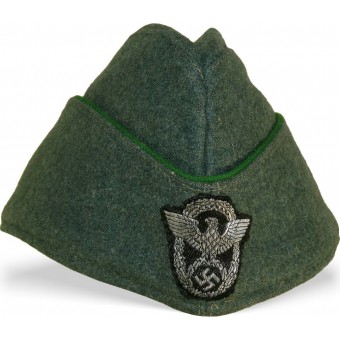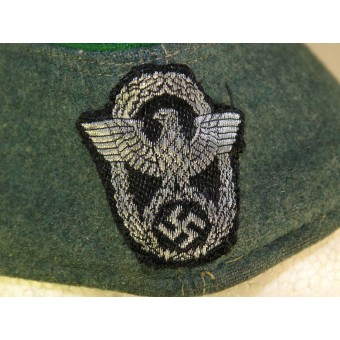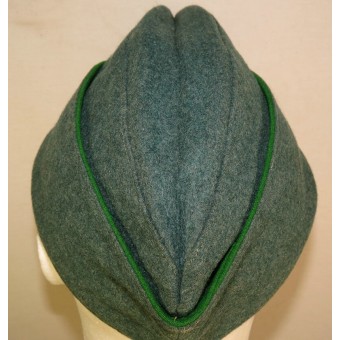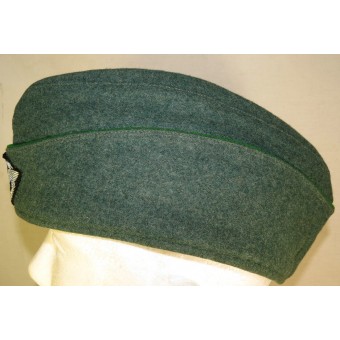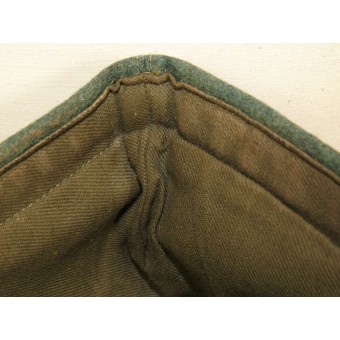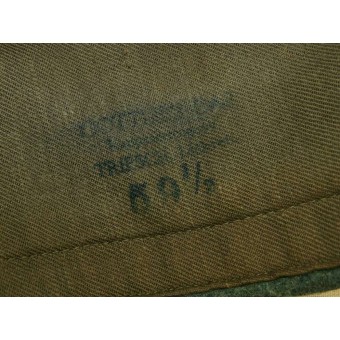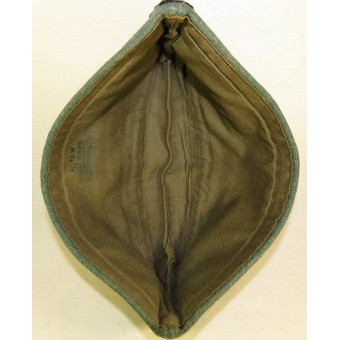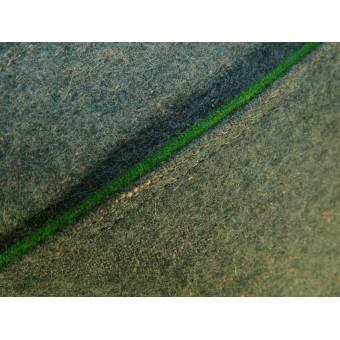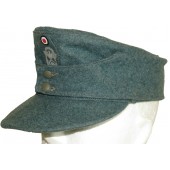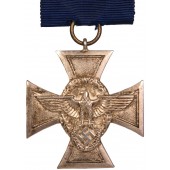Ordnungs Polizei - Gorra de policía OrPo
Esta es una traducción automática. Para ver el texto original en inglés haga clic aquí >>
The ranks and insignia of the Ordnungspolizei were developed in 1936 after the nationalization of Germany's regular police forces.
Contents
Ordnungspolizei rank titles
Ordnungspolizei (Orpo) ranks were based on local police titles and were considered a separate system from the ranks of the SS. It was also possible for Orpo members to hold dual status in both the Orpo and the SS, meaning that two ranks could be held simultaneously. In the case of Orpo generals, equivalent SS rank was always held in which case the Orpo general would be addressed by their SS rank first, followed by their police titles (for example: SS-Obergruppenführer und General der Polizei). In 1944, all Orpo generals also gained equivalent Waffen-SS rank so that, in the event of capture by the Allies, the Orpo general would hold status as a military officer instead of a police official.
Orpo personnel who were also members of the Allgemeine-SS were authorized to wear an embroidered SS Sigrunen patch on the breast pocket.
Ordnungspolizei rank insignia
In addition to collar and shoulder insignia, Ordnungspolizei also wore the wreathed police eagle on the upper left sleeve. The collar patch and shoulderboards were backed, and the sleeve eagle (below the rank of Leutnant) embroidered, in truppenfarbe, a color-code which indicated the branch of police: green for Schutzpolizei (protection police) and police general officers, wine-red for Gemeindepolizei (municipal protection police), orange for rural Gendarmerie, carmine-red for fire brigades, gold for maritime police, light grey for administrative police.[1]
| Orpo general rank | SS equivalent | Shoulder insignia | Collar insignia
|
Collar insignia
|
| Chef der Deutschen Polizei | Reichsführer-SS | |||
| Generaloberst der Polizei | Oberstgruppenführer | |||
| General der Polizei | Obergruppenführer | |||
| Generalleutnant der Polizei | Gruppenführer | |||
| Generalmajor der Polizei | Brigadeführer |
Note: Since most police generals, increasingly as time went on, were also SS generals, they typically wore an SS uniform except at police-specific functions.
| Orpo officer rank | SS equivalent | Shoulder insignia | Collar insignia |
| Oberst der Polizei | Standartenführer | ||
| Oberstleutnant der Polizei | Obersturmbannführer | ||
| Major der Polizei | Sturmbannführer | ||
| Hauptmann der Polizei | Hauptsturmführer | ||
| Oberleutnant der Polizei | Obersturmführer | ||
| Leutnant der Polizei | Untersturmführer |
| Orpo enlisted rank | Translation | SS equivalent | Shoulder insignia | Collar insignia |
| Meister | Master | Sturmscharführer | ||
| Hauptwachtmeister | Chief watch master | Hauptscharführer | ||
| Revier-oberwachtmeister
|
Precinct senior watch master
|
Oberscharführer | ||
| Oberwachtmeister | Senior watch master | Scharführer | ||
| Wachtmeister | Watch master | Unterscharführer | ||
| Rottmeister | Team master | Rottenführer | ||
| Unterwachtmeister | Junior watch master | Sturmmann | ||
| Anwärter | Candidate | Mann |
- Source:[Wikipedia
Esta es una traducción automática. Para ver el texto original en inglés haga clic aquí >>
The ranks and insignia of the Ordnungspolizei were developed in 1936 after the nationalization of Germany's regular police forces.
Contents
Ordnungspolizei rank titles
Ordnungspolizei (Orpo) ranks were based on local police titles and were considered a separate system from the ranks of the SS. It was also possible for Orpo members to hold dual status in both the Orpo and the SS, meaning that two ranks could be held simultaneously. In the case of Orpo generals, equivalent SS rank was always held in which case the Orpo general would be addressed by their SS rank first, followed by their police titles (for example: SS-Obergruppenführer und General der Polizei). In 1944, all Orpo generals also gained equivalent Waffen-SS rank so that, in the event of capture by the Allies, the Orpo general would hold status as a military officer instead of a police official.
Orpo personnel who were also members of the Allgemeine-SS were authorized to wear an embroidered SS Sigrunen patch on the breast pocket.
Ordnungspolizei rank insignia
In addition to collar and shoulder insignia, Ordnungspolizei also wore the wreathed police eagle on the upper left sleeve. The collar patch and shoulderboards were backed, and the sleeve eagle (below the rank of Leutnant) embroidered, in truppenfarbe, a color-code which indicated the branch of police: green for Schutzpolizei (protection police) and police general officers, wine-red for Gemeindepolizei (municipal protection police), orange for rural Gendarmerie, carmine-red for fire brigades, gold for maritime police, light grey for administrative police.[1]
| Orpo general rank | SS equivalent | Shoulder insignia | Collar insignia
|
Collar insignia
|
| Chef der Deutschen Polizei | Reichsführer-SS | |||
| Generaloberst der Polizei | Oberstgruppenführer | |||
| General der Polizei | Obergruppenführer | |||
| Generalleutnant der Polizei | Gruppenführer | |||
| Generalmajor der Polizei | Brigadeführer |
Note: Since most police generals, increasingly as time went on, were also SS generals, they typically wore an SS uniform except at police-specific functions.
| Orpo officer rank | SS equivalent | Shoulder insignia | Collar insignia |
| Oberst der Polizei | Standartenführer | ||
| Oberstleutnant der Polizei | Obersturmbannführer | ||
| Major der Polizei | Sturmbannführer | ||
| Hauptmann der Polizei | Hauptsturmführer | ||
| Oberleutnant der Polizei | Obersturmführer | ||
| Leutnant der Polizei | Untersturmführer |
| Orpo enlisted rank | Translation | SS equivalent | Shoulder insignia | Collar insignia |
| Meister | Master | Sturmscharführer | ||
| Hauptwachtmeister | Chief watch master | Hauptscharführer | ||
| Revier-oberwachtmeister
|
Precinct senior watch master
|
Oberscharführer | ||
| Oberwachtmeister | Senior watch master | Scharführer | ||
| Wachtmeister | Watch master | Unterscharführer | ||
| Rottmeister | Team master | Rottenführer | ||
| Unterwachtmeister | Junior watch master | Sturmmann | ||
| Anwärter | Candidate | Mann |
- Source:[Wikipedia


